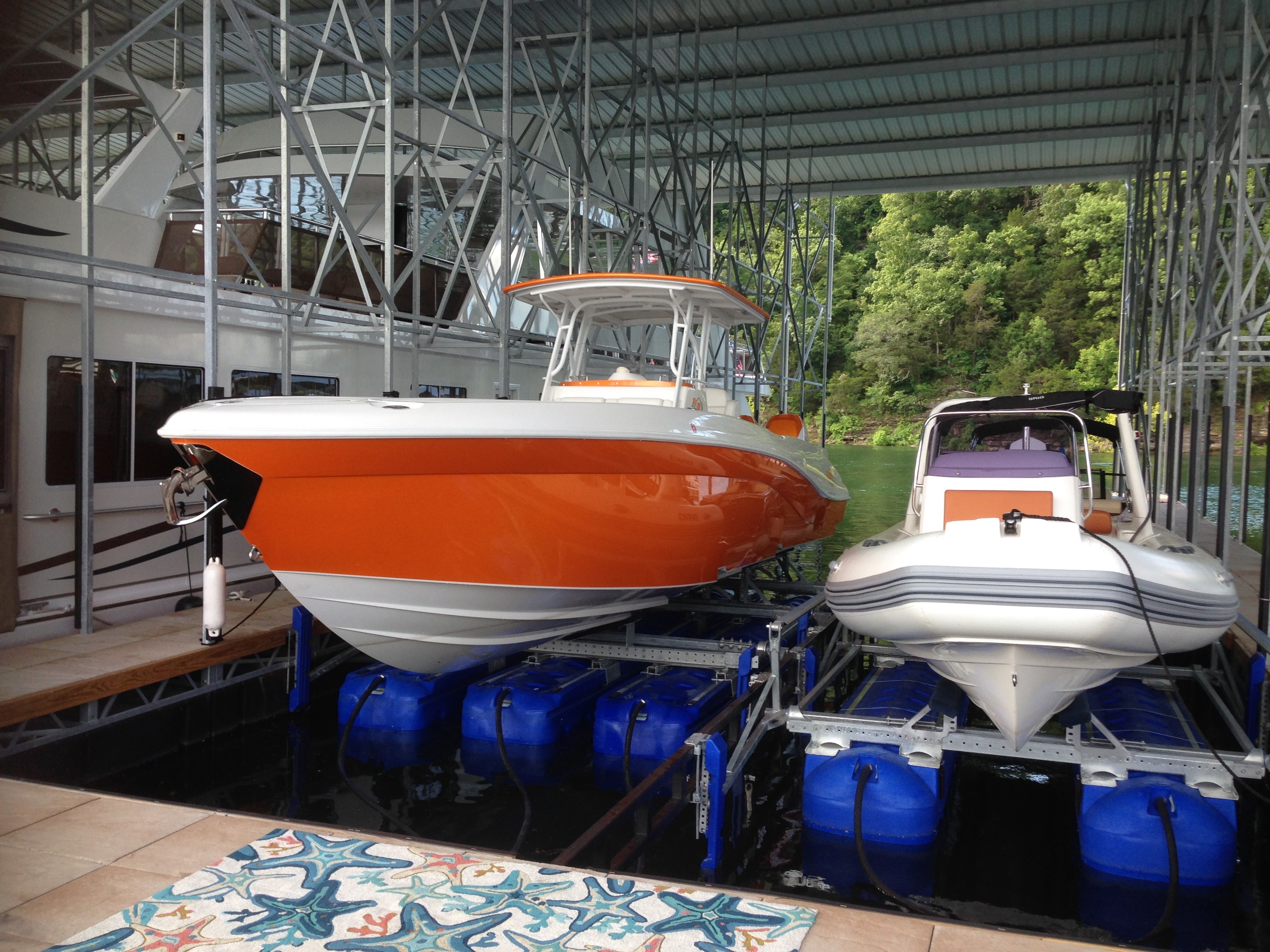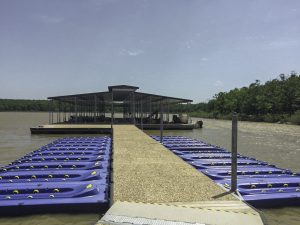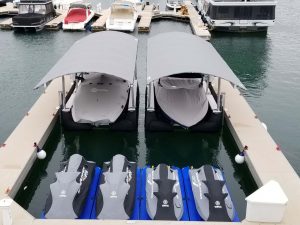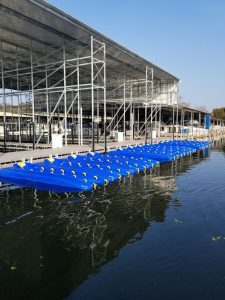
Boaters Continue to Demand Boat Lifts, Bringing Marinas Additional Revenue
Published on November 12, 2019Boating has evolved. What started as a simple means to traverse the water grew into large scale fishing and transportation. This utilitarian start gave birth to a recreational lifestyle that is now enjoyed by people worldwide. In the U.S. alone, there are an estimated 87 million recreational boaters.
As the lifestyle and the vessels have evolved, so have the wants and needs of the boater. Symbiotically, marinas have also evolved. Simple landings and docks have grown into multiple slip facilities offering all of the comforts of home. Ship’s stores have grown from bait and tackle supplies to full-service centers. Depending upon the location and size of the facility, the list of amenities offered is substantial. Marina owners and managers are constantly striving to better the customer’s experience, while at the same time guarding the bottom line.
Boat Lift Benefits
By now, most in the industry know that boats are made to play in the water and not to stay in the water. Regardless of the style of boat, whether it is a wake boat, runabout, deck boat, fishing boat, pontoon boat, or even a PWC, all vessels can be victims of corrosion. It goes beyond simply being dirty. Boaters are left with three choices when it comes to protecting their vessels from the harsh effects of prolonged exposure to water and electrolysis. Boaters must either trailer their boats; store them in a drystack facility, or dry dock the boat in the slip.

For any boater that wants year-round slip access and less boat maintenance, dry docking the boat on a hoist in the slip is the best choice. The boat lift will provide the protection needed against water and electrolysis damage, while at the same time avoiding the hassle and lost time that comes with trailering or storing the boat in dry storage. Modern boat lifts are easy to operate and can actually aid in docking the boat. Boat lifts are available in many varieties and can match almost any mooring application, whether it is a single wide slip, a double wide slip, or a simple landing. Boat lifts can also be installed to accommodate vessels that are pulled forward or backed into the slip.
Investing in a boat lift is not as costly as most boaters might think. In many cases it can actually save the customer money by increasing the resell value of the boat, and avoiding having to pay separate fees for a slip and a dry storage facility, or added maintenance. The ease of operation will, in many cases, increase the number of times that they actually use their boats. Want to go on a quick ride to watch the sunset? A push of the button and within five minutes the boat is in the water and ready to go. Return to the slip, another push of the button and within five minutes the boat is high and dry and boaters are good to go.
Boat Lift Styles

Boat lifts are available from many manufacturers, and in different designs to accommodate the various dock systems. Floating hoists are the best design to mate with floating docks, and suspension hoists or bottom-standing hoists will more often be paired with fixed docks or docks that are built on piling.
The style of dock is most often determined by the type of water that it is situated on. For example, a deep water lake or reservoir, especially one that has fluctuating water levels, will best be served by floating docks that can move with the water level, and a floating hoist will move in tandem with the dock. These style docks are also installed in coastal applications with deep water coves. Hydro-pneumatic floating lifts use air tanks to support the lift and the boat. The air tanks are inflated to raise the hoist, and flooded to submerge it. Other floating hoists use a combination of solid floats and hydraulics to raise and lower the boat.
These hoist are versatile and can be installed for a broad range of vessels, and can be setup for boats that are driven forward into slips. Where enough water depth exists for the hoist to submerge below the drives of the boat, they work also for boats that are backed into slips. This is often the preferred mooring position for rear entry boats, or for boats that are longer than the slip.
Shallow water lakes and reservoirs, with minimal water level fluctuation often use fixed docks or docks that are built on piling. This style dock is also used in coastal applications with shallow water. Suspension lifts use a cable and winch system to raise and lower the lift frame and the boat. This system can often be attached directly to the dock structure, and other times will require stand-alone piling to support the hoist system.

Bottom standing or free standing hoists sit directly on the lake or ocean bed. These hoists use either a cable or hydraulic system to raise and lower the lift and the boat. They are available with manual operating systems, and also with electric motors.
Regardless of the dock design; there is a hoist system out there to accommodate just about all of them. Modern boat lifts are also equipped with accessory features, such as remote controls, boat guides and access walkways to make them user friendly and to maximize customer satisfaction.
Boat Lift Dealer
Boat lifts are no longer a niche industry. They are becoming a more necessary, mainstream part of the boating lifestyle, and requested by many slip customers in certain areas. A boat lift dealership is an excellent way for any marina to add more revenue; while at the same time adding to the customer experience. If marinas sell or lease hoists directly to their boaters, not only are they increasing revenue and enhancing the customer experience, but they are also taking control of exactly who is installing the lifts into their facilities. This gives marinas the opportunity to vet the installers and to directly control the quality of the installation, ensuring the safety of the boat, dock and the hoist.
Floating and suspension lifts, regardless of the manufacturer, are only as good as the installation. Floating lifts are attached to the dock via clamps or brackets. These must be securely attached to ensure that the hoist will remain attached to the dock during operation, and especially in the event of inclement weather. Suspension lifts, by design, literally suspend the boat in the air from cables. The cable supports must be securely fastened to the dock or the piling to ensure solid and safe hoist performance. The hull support systems must also be adjusted to properly fit the boat. Bottom standing or free standing lifts are not usually attached to the dock; however, they also must be properly placed and setup for the boat. Regardless of the type of lift a boater needs, a quality installation is essential to maximizing the safety and longevity of the product, as well as the customer satisfaction, and the marina’s total return.
Marina operations profit in many ways from offering boat lifts to their tenants. Directly, they can sell the or lease the lift to customers. Indirectly, they benefit from a more dedicated consumer. At the end of the slip lease agreement, it is a simple matter to drive your boat to the ramp and trailer it to a new home. A boat lift on the other hand is a bit more involved when it comes to removal and relocation. A customer that buys and installs a hoist is truly committed to that slip. With PWC units, having a designated area for drive on docking platforms can also aid in the traffic flow within the facility. Those boaters can dock easier and more safely.
Your tenants have already entrusted you with the storage and safety of their boat. It only makes sense to take your customer service to the next level by adding a boat lift dealership to your facility.
Scott Mauldin is regional director for the Southeast and HydroHoist, LLC. He can be reached by phone at 931/372-8928 or via email at smauldin@boatlift.com.
| Categories | |
| Tags |





